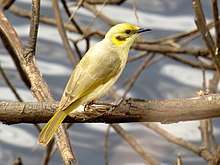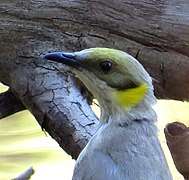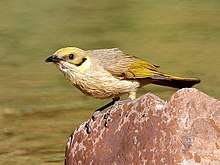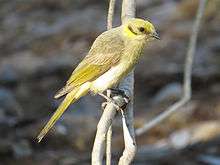Grey-fronted honeyeater
The grey-fronted honeyeater (Ptilotula plumula) is a species of bird in the family Meliphagidae. It is endemic to Australia. Its natural habitat is Mediterranean-type shrubby vegetation. The grey-fronted honeyeater was originally described in 1841 by English ornithologist John Gould as Lichenostomus plumulus. It was moved to the genus Ptilotula after a molecular phylogenetic analysis, published in 2011, showed that Lichenostomus was polyphyletic.[2][3]
| Grey-fronted honeyeater | |
|---|---|
 | |
| Gregory River, Queensland | |
| Scientific classification | |
| Kingdom: | Animalia |
| Phylum: | Chordata |
| Class: | Aves |
| Order: | Passeriformes |
| Family: | Meliphagidae |
| Genus: | Ptilotula |
| Species: | P. plumula |
| Binomial name | |
| Ptilotula plumula (Gould, 1841) | |
| Synonyms | |
| |
Description
The grey-fronted honeyeater is a small, plain honeyeater with a yellow neck plume bordered above by black. It has a small grey patch at the forehead, that may be obscure in northern subspecies. The crown is olive yellow and the lores blackish. The upper parts are olive grey and flight feathers yellow olive. Underparts are off white with indistinct stripes. The grey-fronted honeyeater can easily be confused with the yellow-tinted honeyeater as their ranges overlap and they are of similar size. Differences include the lores which are yellow grey and plumes that are narrower in the yellow-tinted honeyeater.[4]
Gallery
 Closeup of head highlighting the small grey patch between the bill and forehead from which the bird gets its common name
Closeup of head highlighting the small grey patch between the bill and forehead from which the bird gets its common name Gregory River, Queensland
Gregory River, Queensland Gregory River, Queensland
Gregory River, Queensland
References
- BirdLife International (2012). "Lichenostomus plumulus". IUCN Red List of Threatened Species. 2012. Retrieved 26 November 2013.CS1 maint: ref=harv (link)
- Nyári, Á.S.; Joseph, L. (2011). "Systematic dismantlement of Lichenostomus improves the basis for understanding relationships within the honeyeaters (Meliphagidae) and historical development of Australo–Papuan bird communities". Emu. 111: 202–211. doi:10.1071/mu10047.
- Gill, Frank; Donsker, David (eds.). "Honeyeaters". World Bird List Version 6.1. International Ornithologists' Union. Retrieved 28 January 2016.
- Menkhorst, Peter; Rogers, Danny; et al. (2017). The Australian Bird Guide. Clayton South, Victoria: CSIRO. p. 380. ISBN 9780643097544.
